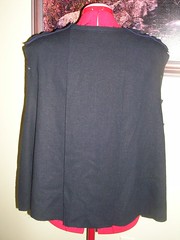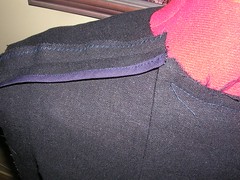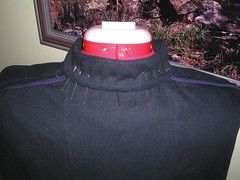I have put the zipper in the navy skirt. (It doesn't look navy at all, but that's a trick of the light.)

As usual, I machine baste the opening edges together and then pin the zipper from the inside, pinning down the middle of the zipper tape. Then I baste down the outside edges of the zipper tape, because I sew down the middle from the right (outside) side and I don't want to try to pick basting thread out from machine sewed thread.

Here's the back of the jacket showing the one large pleat. I put the jacket on Rose inside out to show it from the wrong side.

Here's a close-up of the shoulder seam. I am putting seam binding on only one side of this seam to finish it. The other side, I zigzagged to make it more sturdy for future long-term wearing, but it will be covered by the front facing so I don't need to put seam binding on both sides of the seam.

And here is where I am tonight, hand sewing the collar facing in between the edges of the front facings. I often machine sew these things but when I am trying to achieve a more couture look, I will make the effort and hand sew with tiny stitches.
4 comments:
I never thought to baste the zipper on the edge to keep from picking the thread out. Tips like this is often omitted. Thanks!
How do you decide when to press your seams open or serge them?
Hey Charlene, after a few too many times of trying to get the basting thread ALL out, I came up with this better way of doing it (in my opinion). I often study a problem and try to figure out a better way because there is almost always more than one way to do everything!
You might not believe it but I have never owned or used a serger! One year, I suppose I will get one and then it will be like the clapper and I'll wonder how I ever got along without it. Except the clapper only cost $25 and a serger is like $800 and up.
Usually I finish my visible seams with the flat fell. Sometimes, I zigzag the edges and press the seam open. Sometimes I make a French seam and only occasionally do I zigzag the raw edges together and trim the excess, like serging. The fabric itself helps me to decide and the kind of garment too. A casual cotton thing will get the flat fell. But that delicate silk top I just made got the raw edges zigzagged together, trimmed and gently pressed to one side. So it depends on what the finish will look like on the outside too (the flat fell shows and is therefore a design element) and all this helps me make my choice.
I have a brother serger and it only cost $199 at amazon about a year ago. I love it! I didn't want to spend to much because I don't sew very often and it gets the job done.
Your jacket is coming along nicely. I noticed on a previous post that you explained why you use pins and instead of basing for the sleeve. Do you ever have to cut the sleeve cap down to reduce fullness so you want have puckers.
I don't think I've ever heard of a serger for that amount of money! I may have to start shopping.
I have never altered my patterns or sleeve caps for two reasons: 1. I am lazy (which also explain why I don't tend to baste), 2. they seem to fit me without alterations, except I do take sleeves and skirts UP (I am only 5'2"). I do occasionally get puckers and tucks on some sleeves and I just shrug and call it a design feature. Or look away and pretend it isn't there. Other things bother me more, I guess. :)
Post a Comment